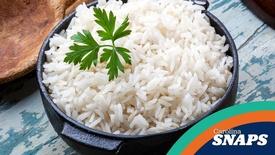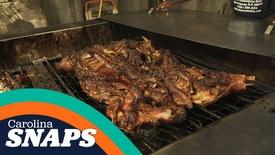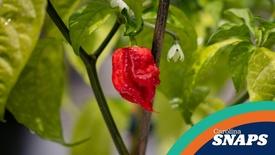
South Carolina is known for many things--some better than others--but one thing that we are undoubtedly great at is cooking. South Carolinian dishes influence the larger conscience and often don't get the credit they deserve. To show some love to the foods that make South Carolina what it is, and to hopefully educate you, let's learn about some dishes and staples of our Southern diet.
Carolina Snaps highlights South Carolina's people, places, and significant historical events...all in a snap! These 60-second episodes can be found on Instagram Reels, Facebook Reels, YouTube Shorts, scetv.org, and the SCETV App.
Rice and Its Impact
Rice is a staple of many cuisines around the world, but its abundance in South Carolina has a complicated history. Rice is said to have been introduced to America by John Thurber in 1685, when he landed in Charleston, SC, looking to have his boat repaired after a storm. He exchanged a bag of rice from Madagascar with Henry Woodward, a doctor and explorer, as a thank you for his hospitality. When rice proved to thrive, it quickly became the primary crop of South Carolina. It was integral to the explosion of plantation culture in the state and was the reason the first thousands of slaves were brought to South Carolina to cultivate this “gold” crop. South Carolinians have embraced rice, and we admittedly don’t think about the origin of rice in the first place, but maybe we should.
One southern meal that relies on rice is Chicken Bog. Chicken bog is a regional dish that combines rice, chicken, and sausage, originating from the Myrtle Beach area. Its name hails from its location as well, with “bog” referencing the boggy areas in which people make and eat this dish.
Hoppin John is also a Carolinian combination that includes rice, as well as peas and pork. Originating in the low country and having a name that is mired in debate, Hoppin John became a popular dish among the formerly enslaved, as slave traders often used black-eyed peas (the main component of this dish) to feed slaves while traveling. The first recipe appeared in a cookbook dating back to the 1940s, but a similar combination had been eaten by enslaved people for much longer.
Southern Staples
Southerners do not play about their barbecue. And as to where it originated, we will not stir up that pot. But undoubtedly, South Carolina barbecue has a lot to offer. Just in the state, there are four distinct types of barbecue sauces to be found. In the Northwestern region of the state, barbeque sauces lean more tomato-ish, while along the SC-Georgia border, the sauces become fully ketchup-based. On the other hand, barbecue sauces in the Midlands tend to be mustard-based, and sauces in the Northeast are vinegar and pepper-based. Again, barbecue is a serious endeavor here.
You only need to drive down a two-lane South Carolinian road for so long before you approach a sign advertising “BOILED PEANUTS” two or three miles up the way. South Carolinians have been boiling peanuts since colonial times. The snack is simple, usually boiled with only salt and one other spice, and thrown into a cup or any other form of plastic container. The popularity of boiled peanuts is unchallenged by time, as this snack is often enjoyed by the old and young, which is why it is labeled as a staple of South Carolina foods.
Pimento Cheese is a misunderstood gem of Southern cuisine. It is quite versatile, as it can be used as a filling, spread, or in a sandwich, and South Carolinians will add it to their plates any chance they get. Made up of pimento peppers and cheddar cheese (and mayonnaise, cream cheese, or both), the popularity of the spread caused farmers to start mass producing pimento peppers in the hopes of cashing in on the craze.
Another southern staple—Fish and Grits. Fish (or shrimp) and grits are said to have originated in Charleston, SC. Grits are ancient and were originally cultivated by Native Americans. The first recipe was mentioned in the 1950 Charleston Receipts cookbook. There is a combination of ways to prepare this meal, and that variety is most likely the reason that this meal has had the longevity and recognition it has.
Even though Georgia is known as the “Peach state,” South Carolina is actually the largest producer of peaches in the southeast, and only second to California in the whole US. More than 30 varieties are grown in South Carolina, and the growing season lasts from May through August. Peaches are a favorite of many in the south and are included in lots of southern desserts.
Sweet tea is an undeniable staple of the southern diet and has existed in many iterations since the plant was first introduced to the Americas. In 1795, French botanist and explorer Andre Michaux brought the plant with him to Charleston in an attempt to appease the wealthy farmer class' particular tastes. Summerville is often called the "birthplace of sweet tea" as it was the site of the first successful tea farm established by the federal government after a series of failed attempts in other regions. Summerville also hosted the tea farm of Dr. Charles Sheppard, the Pinehurst Tea Plantation, which he founded in 1888. Sheppard later went on to help propel sweet tea to national fame when his tea won first prize at the 1904 St. Louis World's Trade Fair. Today, Summerville embraces its sweet tea heritage, offering lots of related tourist attractions year-round.
The Carolina Reaper
Unlike some of the other foods mentioned in this article, the Carolina Reaper is a relatively new option, having only been invented in the 21st century. The Carolina Reaper was developed by Ed Currie, based out of Rock Hill, SC, and was named one of the hottest peppers in the world. Currie is highly skilled in botany, as well as spice tolerance, and cross-bred the other extremely hot peppers he grew to create the spice-bomb that is the Carolina Reaper.













